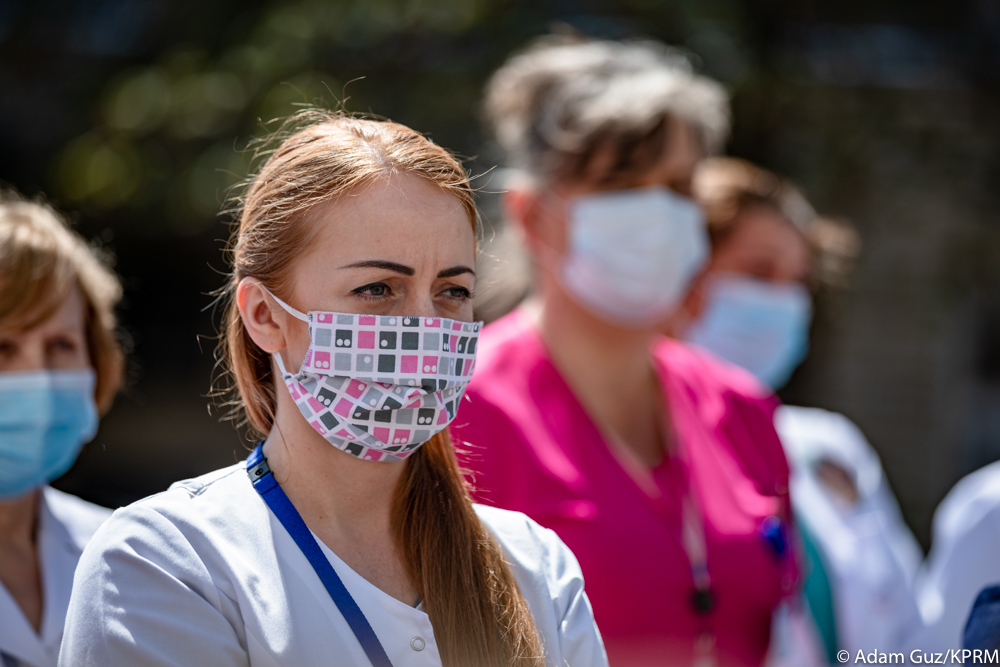Poland has today recorded its highest daily figure of new coronavirus cases to date, 903, as its recent rise in infections continues.
The figures comes just three days after the health minister unexpectedly resigned – with his replacement appointed yesterday afternoon – and 11 days before schools are due to reopen for in-person teaching.
Today’s number of new infections surpasses the previous record of 843, set on 8 August. The number of people currently hospitalised with the virus is 2,151, up from 1,550 in the middle of July. However, Poland still remains below the peak of hospitalisations and deaths recorded in late April.
In response to the recent rise in cases, Poland’s government has introduced a system of red and yellow zones for places that are experiencing higher numbers of infections. Restrictions have been reintroduced in those districts, including the requirement to wear masks in public – both indoors and outdoors – in red zones.
Yesterday the health ministry published an updated list of which districts are now classified as red and yellow. The worst outbreaks have been in the south of the country, in the Małopolska and Silesia provinces.
Kraków and Katowice, the capitals of those provinces and two of Poland’s largest cities, have been put on a warning list of places that are on the verge of being classified as red or yellow zones.
⚠️ Aktualna lista powiatów objętych dodatkowymi obostrzeniami (żółtymi i czerwonymi).
Zmiany będą obowiązywać od jutra (21.08).#koronawirus pic.twitter.com/unlz94YDNW
— Ministerstwo Zdrowia (@MZ_GOV_PL) August 20, 2020
Many of the largest recent outbreaks have been traced to weddings, which were allowed to resume in early June with up to 150 guests as Poland loosened its lockdown restrictions.
Earlier this week, 120 guests and staff who had attended a wedding in Małopolska were quarantined after two guests were later diagnosed with COVID-19. Following a wedding in Silesia, 90 people are in quarantine and 22 have already tested positive, reported RMF24 yesterday.
Amid the current peak of infections, Poland’s health minister, Łukasz Szumowski, unexpectedly resigned on Tuesday. He claimed that his departure had long been planned, and that it would give his successor time to prepare for a potential second wave of coronavirus and a flu outbreak in the autumn.
Critics, however, noted that Poland is already experiencing its highest wave of cases to date, and that less than two weeks earlier Szumowski had promised not to “abandon ship” during the current situation.
The opposition have suggested that his departure could be related to prosecutors’ investigations into allegations over the purchase of overpriced and faulty equipment during the pandemic.
The government has moved quickly to replace Szumowski. Yesterday afternoon, the prime minister announced that Adam Niedzielski, an economist who currently heads the National Health Fund (NFZ), will be the new health minister.
Reopening schools
The rise in cases also comes as Poland prepared to reopen schools for the start of the academic year on 1 September. The government shut down schools in March, as it introduced one of Europe’s earliest and toughest lockdowns.
In May, children attending nurseries, preschools and the youngest year groups in schools were allowed to return. But the majority of pupils remained at home, with plans being put in place for them to return to schools on 1 September.
Earlier this week, the education minister, Dariusz Piontkowski, confirmed that these plans were still on track, and sought to reassure people who were worried that reopening schools could contribute to further spread of the virus.
“Please remember that the school buildings have been empty for several months, so the buildings themselves are not infectious,” Piontkowski told Radio Gdańsk. “It seems that schools can function calmly in the vast majority of districts while maintaining the basic rules of hygiene and safety.”
Yesterday, Piontkowski presented parliament with a report on the state of preparations for the reopening of schools. He said that “the overwhelming majority of schools will operate normally”, reports Gazeta Wyborcza.
However, school headteachers, in consultation with the sanitary authorities, can make an individual decision on whether to switch to partial of full distance learning for pupils if they feel that the epidemiological situation requires it.
Piontkowski confirmed that, although a strict new sanitary regime will be in place, pupils will not be required to wear masks during classes. He also appealed to parents to ensure that they do not send children who are feeling ill to school.
Main image credit: Adam Guz/KPRM (under CC BY-NC-ND 2.0)

Daniel Tilles is editor-in-chief of Notes from Poland. He has written on Polish affairs for a wide range of publications, including Foreign Policy, POLITICO Europe, EUobserver and Dziennik Gazeta Prawna.




















